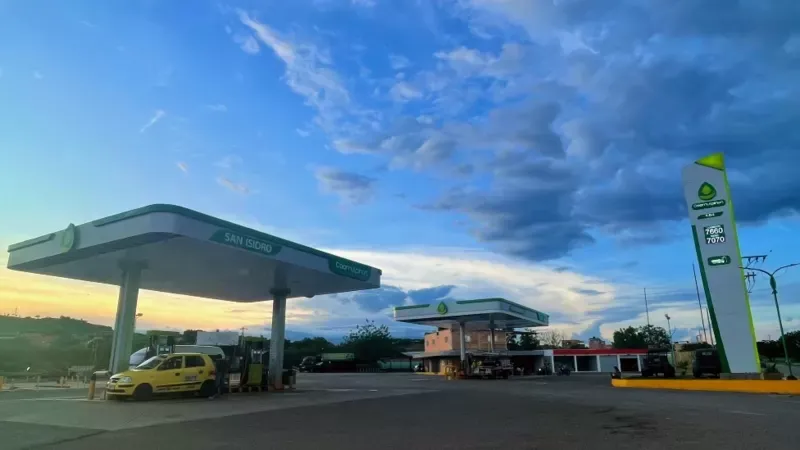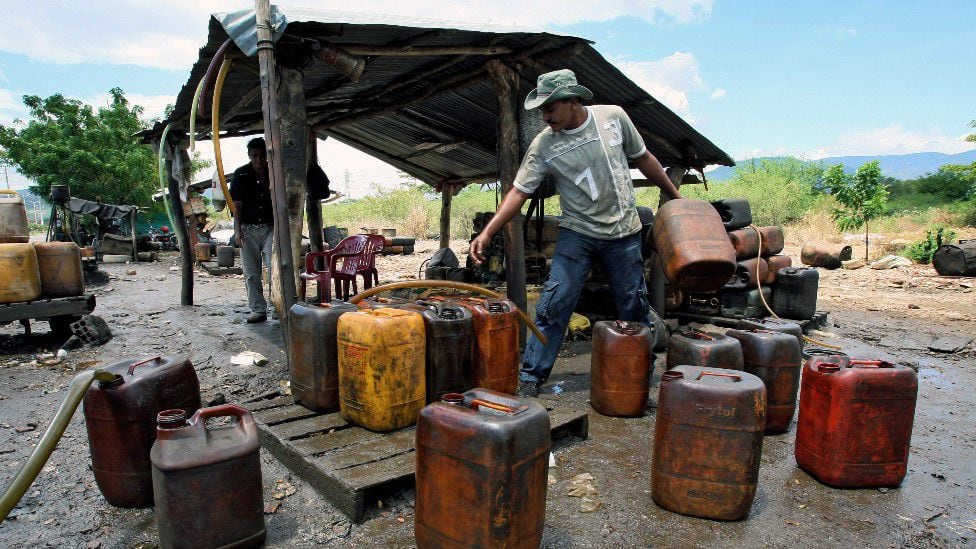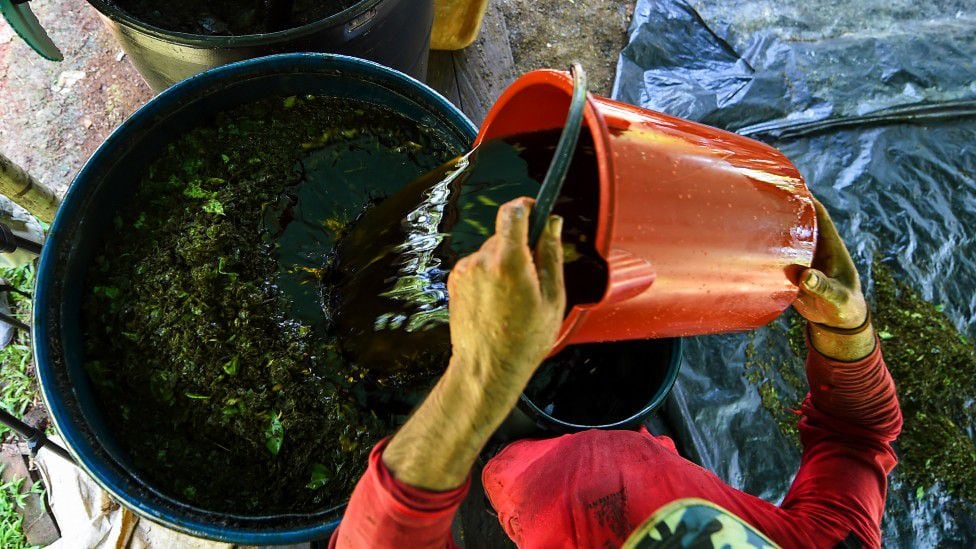:quality(75)/cloudfront-us-east-1.images.arcpublishing.com/elcomercio/GIYTCMZNGEYS2MBXKQYDAORSGE.jpg)
They are in every conversation and seem to be around every corner. People comment on them, ask about them. No one really knows what’s behind it. But in Cucutathe largest Colombian city on the border with Venezuelathere is a boom of gasoline stations.
They almost all look new, or are remodeled. Very few have a store, or services other than tanking. Some received complaints because they were set up in residential areas, or near hospitals. Most of them have the Terpel brand, one of the largest companies in the country, due to a law that forces them to take shelter with wholesalers, but, in reality, They are ventures of small and medium entrepreneurs.
LOOK: The new US plan for Venezuelans responds to the fact that “Biden was between a rock and a hard place”
On the highway that surrounds the capital city of Norte de Santander, known as the western ring road, there is a 1-kilometer section with seven stations, one almost next to the other. Some are finished, others under construction, but all are about to be released.
“We are living a boom“, says Alberto Andrés Moros, owner of a station. “But to understand this phenomenon you have to see the context of a region where until 2015 there were many people, many taxi drivers, who never in their lives, literally, had tanked their car so legal”.
In 2014 there were some 125 stations in Norte de Santander, according to data from trade associations. Today there are 250.
“I still I don’t understand how so many could make so many stations in such a short time“, says Moros, who inherited the station from his grandfather.
Many cucuteños accompany him in perplexity.
But behind this boom in gas stations is Cúcuta’s historic link with Venezuela, a country that, both in its crisis and in its heyday, has determined the daily life of the city.
And there is also, according to official studies, a part of the cocaine production chain, which has, not far from Cúcuta —150 kilometers— one of the regions with the highest production of coca leaves in the world: Catatumbo.
BBC Mundo received a statement from one of the main wholesalers in the sector – who asked not to reveal her name for fear of reprisals – in which they assured have “processes for the prevention, detection, and investigation of conduct suspected of crimes of money laundering and financing of terrorism”.
More than the number, the boom
250 gas stations in a Colombian department is not much. In Antioquia and Bogotá, the two economic centers, there are three times as many stations.
And in Nariño, a department bordering Ecuador, there are over 700. In proportion, it is this last department of southern Colombia, also a cocaine production center, where there are more stations per 100,000 inhabitants: 41.1.
In Norte de Santander, for its part, there are 16.6 gas stations for every 100,000 people. A high figure, but not far from the average, which in any case is turning Cúcuta into one of the cities with the most stations per capita.
But what is peculiar to this area, more than the number itself, is the boom in such a short time: seasons doubled in five years.
“And that is because there has been a formalization of the market, because people invested, because people have a sense of belonging and love their land,” says María Eugenia Martínez, director of the Association of Service Stations of Norte de Santander.

The pimpineros were formalized
According to the union, in 2014 80% of the gasoline supply in Cúcuta he was supplied with the contraband that came from Venezuela, where at that time the fuel, produced by the state-owned PDVSA, was sold for symbolic sums; almost free.
The smuggling of gasoline from Venezuela—a country with the largest oil reserves in the world and for decades one of its largest producers—created a parallel fuel market on the Colombian border.
Their managers were the famous pimpineros, informal vendors who brought them in 5-gallon (19-liter) bottles, known here as “pimpinas.”
But from 2015 onwards Venezuela entered into crisis: its industry declined, some of its thick oil refineries closed and the government of Nicolás Maduro had to partially dismantle the generous gasoline subsidy.
At the time, the diplomatic dispute between Bogotá and Caracas ended up closing the border. Smuggling continued, but with more obstacles that increased prices.
“The pimpineros were running out of business, the people who already had stations began to set up new points of sale and then the businessmen, who saw that the queues of up to 100 vehicles at the stations were up to an hour, decided to investMoors says.
Even the pimpineros associated themselves and set up a fuel distribution company.

“Second capital of Venezuela”
The shock of the Venezuelan crisis was so great that there have been sporadic moments in which local gasoline —5%, according to study centers— is smuggled in reverse: from Colombia to Venezuela.
Dozens of Venezuelan restaurants and brands and businesses have set up a subsidiary of their business in this city of 800,000 inhabitants, famous for having more trees than inhabitants. Here are the most satisfied consumers in Colombiaaccording to state studies, despite having the highest labor informality in the country.
“Venezuela is now reactivating itself, and that has repercussions in Cúcuta: every Venezuelan who wants to leave the country passes through here, consumes here, pours gasoline here, and that is turning Cúcuta into the second capital of Venezuela, because indirectly we are supplying them in everything,” says Moros.
Although not at the Venezuelan level, the Colombian State also subsidizes gasoline. An aid that the president, Gustavo Petro, wants to eradicate due to the deficit that he generates.
And at the borders, since 1995, gasoline is also exempt from taxes, precisely to compete with contraband. A measure that was unsuccessfulbecause in Venezuela they almost gave away the fuel, but that does make an important part of the gasoline sold in Colombian border areas one of the cheapest in Latin America.
“That is still in force, and makes many companies from nearby regions come here to stock up on gasoline,” explains Moros. “Demand is up and that’s why many see a business there.”

From laundering to drug trafficking
But there are those who see beyond the laws of supply and demand. In a region where illegality has always been part of the routine, it is hardly normal for people to distrust such an accelerated rise in stations.
On the one hand, there is the suspicion, deeply rooted in Colombia, that a business that does not seem competitive is “a laundry“: an undertaking to launder illegal income.
“Criminal structures have financial resources and advisers to manage the station before the competent authorities, in addition to the fact that state institutions are not strong and do not follow up on requests,” says Yessica Prieto, a consultant at Crudo Transparent, a think tank.
The expert assures that “The drug traffickers take that legal gasoline to divert a part to the manufacture of alkaloids and another part they leave for sale as a front or for smuggling”.
The gasoline wholesaler who spoke to BBC Mundo said it has “verification mechanisms in restrictive lists of its clients/counterparts (UN terrorists, for example) and this information is constantly updated and verified for the purposes of carrying out the procedures of knowledge of the client.
An internal 2018 report from the Ministry of Finance published by El Espectador says that “in areas where there is a presence of illicit crops, there is evidence of an excess of service station infrastructure compared to that explained by population, vehicle fleet and other covariates. That subsidy ends benefiting cocaine producers”.
And another study by the Ministry of Mines and Energy —also reported by El Espectador— concluded that in Colombia 22 gallons of legal gasoline are used for every kilo of coca paste produced.
The Bogota newspaper concluded: “Thus, close to 1% of the country’s gasoline is being used for illegal activities.”

Moros, the owner of a station in Cúcuta, says that it is very difficult for him to know what customers do with the product: “There is a legal requirement that one asks those who buy a lot of gallonage, but they present it that way, we are not the police to keep track of the fuel.
And Santiago Soto, a lawyer from Cucuta and a consultant on energy issues, adds: “You shouldn’t be so suspicious about fuel, the determining factor in the boom of the stations is that the dynamics changed, that there is no longer Venezuelan fuel“.
“That there are bad practices does not mean that most of the fuel that is sold is illegal,” he says.
But it is difficult to avoid the suspicion of Cucuteños. Empty stations, in the middle of an inhospitable highway, seem like a lucrative business for criminals.
Behind the suspicion are decades of informal, truculent border life. A life that now entered a new era. An era without pimpineros.
Source: Elcomercio
I, Ronald Payne, am a journalist and author who dedicated his life to telling the stories that need to be said. I have over 7 years of experience as a reporter and editor, covering everything from politics to business to crime.






